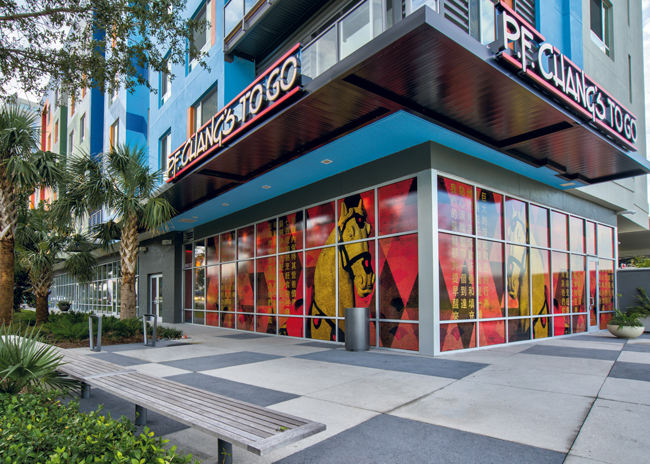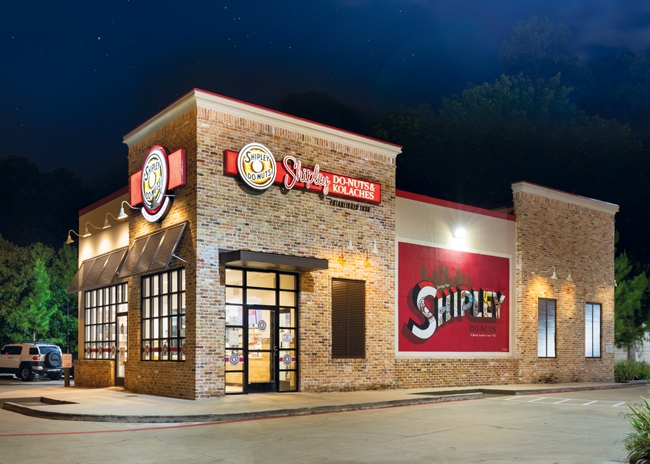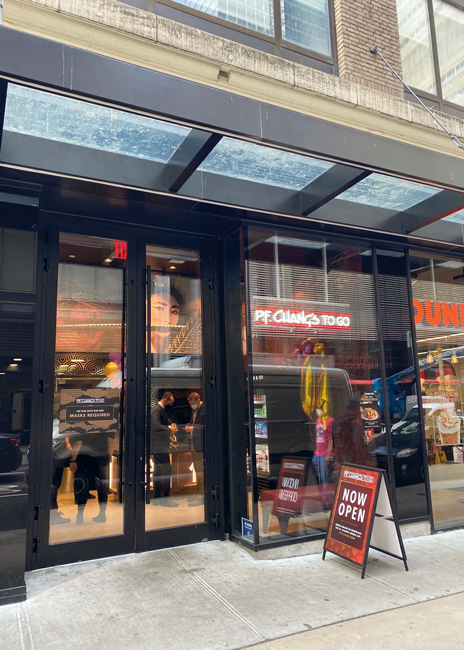Pint-sized restaurant concepts allow operators to open faster and serve the growing off-premises business.
“Small is beautiful” is an idea that a number of restaurants continue to embrace in the post-pandemic years of decreased on-premises dining. These operations are smaller, more optimized versions of their full-service counterparts and are less costly to operate. That often “translates into faster growth for a brand to expand,” says Darren Tristano, CEO and founder of consulting firm Foodservice Results, Chicago.
 Kitchens have been reconfigured for efficiency in P.F. Chang’s To Go restaurantsOperators continue to develop these smaller or express concepts largely due to the growing demand for off-premises dining. According to Datassential’s 2022 Food at Home Keynote report, 33% of foodservice-sourced meals were eaten at home before the pandemic, compared with 44% last year.
Kitchens have been reconfigured for efficiency in P.F. Chang’s To Go restaurantsOperators continue to develop these smaller or express concepts largely due to the growing demand for off-premises dining. According to Datassential’s 2022 Food at Home Keynote report, 33% of foodservice-sourced meals were eaten at home before the pandemic, compared with 44% last year.
As their nickname implies, the design of these express units promotes speed as these locations tend to offer very few — if any — seats and, in some cases, limited menus. This can be key to better unit economics, Tristano points out, since smaller spaces may cost less rent per square foot, the off-premises focus allows these units to potentially maximize online ordering.
These diminutive locations offer a variety of other advantages. They may rely on less staff due to the greater focus on off-premises customers and online ordering. And when they feature smaller menus, that means less food waste, less space necessary for refrigeration and storage, less prep and less cooking, Tristano says.
Adds Erica Holland-Toll, culinary director for The Culinary Edge, San Francisco, “Especially for operators that can focus on their most popular offerings, most travel-worthy menu items, there is an opportunity to significantly decrease the investment required to build out their space. A limited menu means less equipment and allows the operator to really focus on the menu to match the equipment strategy, guaranteeing the fastest return on their investment.”
However, points out Ken Batali, principal, Batali Associates Hospitality Consulting, Edmonds, Wash., without the bars some of these concepts rely on, restaurants “really have to have their operation dialed in to be able to make money on just food.”
Finding spots for these smaller spaces is also much easier, making restaurants more flexible. “It’s a great way to expand into more expensive urban areas where the cost of large dining rooms and service staff is prohibitive,” says Batali. “It’s a way for a brand to expand their reach or for a start-up to start with less overhead.” It can also be a great way to test a market, he points out, or to shift some business from a full-service location to an express operation, alleviating busy times.
Nashville-based Captain D’s opened its third Express layout, which has a drive-thru and walk-up window but no dining room. It measures just 970 square feet, a significant reduction of the usual 2,000 square feet required for a traditional Captain D’s. The express location serves a streamlined menu to enhance speed of service, and the newly designed kitchen brings faster cook times and a speedier drive-thru.
Genghis Grill’s new store design is the concept’s first foray into the fast-casual dining segment. It allows for quicker and more convenient ordering via cashiers and kiosks and has a much smaller footprint. The new prototype opened in Columbus, Ohio, in June and has a dedicated area for staging and picking up to-go orders. This model uses the latest kitchen and operations technology with a separate to-go order staging area. The new operation includes grills and make/sandwich tables back to back to decrease employee steps and use fewer employees; make/sandwich tables instead of drop-in coolers, which allows for lower buildout costs, doors under the line for restocking, and rearranging the line as needed; and at these locations, staff build all bowls instead of the guest. This design includes kiosk ordering and GPS technology to streamline the to-go channel, allowing the guest and operators to pinpoint pickup times and track delivery drivers’ proximity to the location. Outside, there are multiple curbside pickup parking spots.
 Shipley Lite locations cater to the chain’s off-premises business. The sites are less expensive to run and new units will open slightly faster.
Shipley Lite locations cater to the chain’s off-premises business. The sites are less expensive to run and new units will open slightly faster.
Redesigned Kitchens
P.F. Chang’s has grown its To Go express restaurant side of the business to 20 locations since it first launched the concept in February 2020. The locations include 14 suburban To Go operations and 6 urban ones.
The To Go Locations do best in markets with a full-service P.F. Chang’s anchor, though the chain prefers to place them 5 to 10 miles away from traditional suburban locations to not cannibalize sales, says Candice Barnett, vice president of beverage, off-premises dining and new restaurant operations. The company aims to open To Go stores in urban locations in markets like
New York City or Chicago.
 P.F. Chang’s will use To Go stores as testing ground for new menu items.The P.F. Chang’s To Go restaurants measure around 2,000 square feet, significantly less than traditional units of 7,500 to 10,000 square feet. The To Go kitchen takes up 60% to 80% of the space. “We’ve done what we can to maximize it for efficiency and speed of service,” Barnett says.
P.F. Chang’s will use To Go stores as testing ground for new menu items.The P.F. Chang’s To Go restaurants measure around 2,000 square feet, significantly less than traditional units of 7,500 to 10,000 square feet. The To Go kitchen takes up 60% to 80% of the space. “We’ve done what we can to maximize it for efficiency and speed of service,” Barnett says.
To make its To Go kitchens efficient, P.F. Chang’s has placed workstations in an L shape with kitchen staff on one side so they take fewer steps. Employees on the opposite side verify and pack orders, which front-of-the-house staff then access via a pass-through window.
Employees working in the front of the house place orders onto shelving. “We like to control the flow of orders,” says Barnett. “We like to check orders and give some customer service. We can ask if they are part of our loyalty program and have those conversations that should be happening. It also allows us to manage third-party delivery drivers and ensure those orders are going out accurately.”
P.F. Chang’s To Go restaurants feature an abbreviated menu, with about 65% of the traditional offerings, which comprise 95% of what people want to eat, Barnett says. The company has reduced the menu by eliminating entire categories such as sushi, salads and soup. The smaller stores serve as a great testing ground, Barnett says.
“We can be really agile, try things quickly and cut them quickly if they don’t work well.”
At first, the To Go P.F. Chang’s offered no seating to cater exclusively to pickup and delivery, but the concept has found some customers want to eat on-site, especially in urban locations, Barnett says. Some To Go stores have only counter seating, but P.F. Chang’s has decided it likes the seating. Without it, “it can lack atmosphere,” she says.
Petite Dessert Locations
Shipley Do-Nuts is launching Shipley Lite next year to cater to the company’s online ordering and drive-thru sales, which constitute about 75% of business, says Mike Stout, senior director, franchise development for the Houston-based brand.
Shipley Lite locations will be around 1,000 square feet, or half the size of the doughnut chain’s traditional locations. “This will open the door for us to pursue more ground-up opportunities while using less land,” Stout says. The stores will typically open in a market where there’s a traditional Shipley nearby.
Lite stores will have less storage, but will work as a hub and spoke model, with a traditional store nearby storing inventory for them. But overall, that inventory will be lower and if the Lite store becomes high volume, it could easily bring in more inventory “since we won’t do that through our third-party distribution,” Stout explains.
The company plans to mostly add Lite locations in areas where it has traditional stores, spacing them roughly 10 miles apart. The satellite Lite will receive weekly deliveries. This also means there’s brand recognition in the market before a Lite opens, points out Kenny Wilganowski, director of construction.
Overall construction costs, real estate costs, utilities and AC costs are lower for a Shipley Lite, and once one opens, the Shipley Lites will be less expensive to run, requiring fewer staff and less cleaning. The company continues to look for ways to allow it to open these stores at a faster pace. Shipley is exploring the use of modular buildings and panelized buildings for these stores. The Lites will have patio seating but no interior seats.
Given the importance of drive-thru to the Lite locations, Shipley is working on several technology upgrades, including kitchen display systems screens and screens in the drive-thru showing wait times. The concept is also looking at posting wait times online, too, perhaps allowing loyalty members to assess the wait at their local Shipley before leaving home. Stores will have a pickup window and a third-party pickup area, and food runners will also bring orders outside to guests.
For the back of the house, Shipley will use smaller versions of its equipment and countertop appliances instead of equipment that sits on the floor, says Stout. “We can modify and customize some of our equipment,” he says, such as custom cutting tables for donuts, which would potentially eliminate the need for a dough sheeter that takes up significant space; undercounter retarders and proofer; split drawer warmers for kolaches; and double-sided donut racks. The kitchens will also be more efficiently laid out, he adds. The equipment will also be more proficient and better suited to smaller batch production. “It’s about efficiency from start to finish,” says Wilganowski.
Shipley Do-Nuts is also considering opening Shipley Lites in areas with no traditional store to gain brand recognition faster, opening a Lite and a traditional store simultaneously, which “could help franchisees establish a market quickly.”
Expanding Delivery Radius
Pizza Factory, based in Oakhurst, Calif., opened its first new-generation Pizza Factory Express in November 2021 and now has four of these pocket-sized stores. These units cater to online orders, especially pickup and delivery. This fits well with Pizza Factory’s sales mix as 65% of business is off-premises, points out Steve Gibbs, CFE, vice president of operations.
 Pizza Factory Express locations help the chain service new communities. Menus are curated for speed.Pizza Factory drivers handle most of the delivery, but one store is experimenting with third-party delivery. Each express unit has a pickup window.
Pizza Factory Express locations help the chain service new communities. Menus are curated for speed.Pizza Factory drivers handle most of the delivery, but one store is experimenting with third-party delivery. Each express unit has a pickup window.
The prototype for the Pizza Factory Express store starts at 1,000 square feet, compared with the traditional stores that range from 1,500 to 4,000 square feet. The lobby in the Express model is just 200 square feet. This leaves around 800 square feet for the back of house, the same as traditional locations, says Gibbs.
These small stores make it easier for existing franchisees to open new stores. If a store is too busy, opening an Express location nearby means some customers could shift to that store, if it’s closer to them. There can also be a joint manager and employee crossover, Gibbs points out.
The Express stores are also faster and less expensive to open since they require less furniture, fixtures and equipment and have lower rent — usually around 25% of a traditional store. In fact, adds Gibbs, it costs about half as much to open an Express location than a traditional store.
Pizza Factory Express locations have similar food costs, but the overall traffic is lower, says Gibbs. This is mostly attributed to the loss of alcohol sales. However, the average check for online orders, at $38, is about 5% higher than traditional sales.
Pizza Factory has been looking to grow beyond its West Coast roots, and the Express locations will help it achieve that. They also make it easier to serve new communities, Gibbs points out.
The Express stores “are doing well,” Gibbs says. “They are a different type of restaurant for us because there’s no dining room, so there’s no buffet, no salad bar, no party rooms.” However, the stores do have refrigerated merchandisers with salads and beverages in the lobbies.
The menus at Pizza Factory Express intentionally feature fewer options in categories such as pizza, salad and dessert. “It’s a matter of velocity and the amount of prep we want staff doing,” says Gibbs. “And we’re trying to be as efficient as we can, even though everything is made fresh at each store.”
Only one Express store offers seating, accommodating 24 guests, but for other locations to offer this they’d require 1,200 to 1,500 square feet. They also require fewer employees because the daytime business is not as strong without the salad bar or buffet offerings. “They have less prep in the day, so that saves on labor. And they don’t have to tend to and clean a dining room, and there are very few dishes,” Gibbs points out.
Looking ahead, Pizza Factory Express could work well for nontraditional locations. The company already plans to open an Express in the lobby of a coffee shop in Oakland, Calif. This store will be around 600 square feet, which is possible largely because it will store items in the coffee shop’s walk-in cooler and doesn’t require its own lobby. “We’ll have the opportunity to see our brand in a market we wouldn’t normally,” says Gibbs. Pizza Factory plans to open two to three Express units annually.
Tristano expects to see more express concepts going forward. “As more traditional, larger locations age and need updating, we should see newer restaurant spaces being built to replace them with more contemporary, newer stores,” he says.



